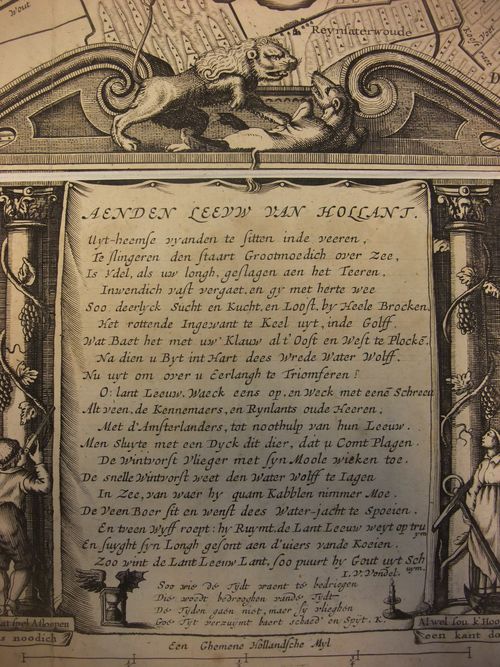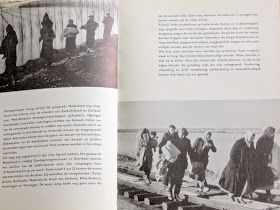De ramp - several photographers - With a letter by the mayor of Amsterdam to the mayor of Middelburg 1953, Litt. Het Nederlandse documentaire fotoboek na 1945, pag. 54
the battle of the flood - several photographers, Litt. Het Nederlandse documentaire fotoboek na 1945, pag. 54
Water - Air - Water. [De Ramp]. [First ori ginal edition, thus].
ZEE LAND -SOUTH HOL LAND PRO VINCE FLOO DINGS 1953
S.I., s.n., February, 1953. Large 8°., original blank limp wrappers, illustrated dustjacket with covertitle in bold black type, "Water". Ti.-p. with tri-lingual text, dutch-indonesian and english (verso blank), introduction, verbatim text of a Radio-speech as held by the H.R.H. the late Queen Juliana of the Netherlands with her full-page captioned portrait, preface with a full-page portrait of Cound Bylandt (honorary Committee Chairman), [70]pp. of captioned black/white illustrations after original air photographs, large extending coloured map featuring the flooded areas, with two inset-maps and key, register printed on verso of map, loosely inserted, 2 facsims. of letters by H.R.H. Bernhard, Prince of The Netherlands and Queen's consort at very end. Entirely tri-lingual edition, dutch-bahasa indonesia-english, including captions to illustrations. Tri-lingual edition of this publication in commemmoration of the national catastrophy which struck the Netherlands in February 1953, commonly called "De Ramp" (The Disaster), striking Zeeland, South-Holland and North-Brabant delta provinces, fetching some 1800 casualties and enormous devastations. Published for the Benefit of the Netherlands Flood Relief Fund.
The media reports on the recent floods in England regularly mention how the Netherlands deals with floods. That’s not surprising, considering the Low Countries’ long history of struggling to keep their feet dry. The Netherlands are in effect a river delta where three big rivers, the Rhine, Waal and Meuse converge to flow into the North Sea. 18% of the land is under sea level and around 50% sits at less than one metre above the sea. Floods have always been a fact of life for the inhabitants, with floods like the St Elizabeth Flood in the 15th century creating whole new landscapes – or should that be waterscapes?
It wasn’t only the sea that threatened the country; lakes and rivers flooded equally regularly. Take the Haarlemmermeer for example. This huge inland lake just south of Amsterdam was nicknamed the Waterwolf, for its ferocious appetite for land. As early as the 17th century engineers thought up plans to drain it, but it wasn’t until the mid-19th century that the Waterwolf was finally tamed. It is now the location of Schiphol airport, as well as towns, fields and roads.

It wasn’t only the sea that threatened the country; lakes and rivers flooded equally regularly. Take the Haarlemmermeer for example. This huge inland lake just south of Amsterdam was nicknamed the Waterwolf, for its ferocious appetite for land. As early as the 17th century engineers thought up plans to drain it, but it wasn’t until the mid-19th century that the Waterwolf was finally tamed. It is now the location of Schiphol airport, as well as towns, fields and roads.
The Lion of the Netherlands fights the Waterwolf; image from Provisionneel Concept Ontwerp ende Voorslach dienende tot de bedyckinge van de groote Water Meeren ([Amsterdam], 1641)
BL Maps * 32635.(1.)
The last major flood the Netherlands experienced occurred twenty years ago, when meltwater from the Alps came rushing down the canalised rivers and the Meuse burst its banks, flooding towns, farms and industrial estates in Limburg and South-Holland. Almost 250,000 people had to be evacuated.
The extent of these floods revealed the lack of maintenance of the dykes and other defences against the rivers at the time. Most resources had gone into the sea defences, especially after the flood disaster of 1 February 1953, the biggest natural disaster the Netherlands had seen since the Middle Ages. Circumstances then resembled those along the British coast this year: a violent South-Westerly storm combined with high spring tides caused a surge in sea levels no one had expected and huge waves crashed into the coastal defences. Dykes were breached in numerous places and the low lying houses and farms were flooded in hours, sometimes minutes.
The pictures shown below are from The Battle of the Floods: Holland in February 1953 (Amsterdam, 1953. BL shelfmark 09406.l.4), an English edition of De Ramp, which was published soon after the disaster in aid of the flood victims. All authors and photographers contributed to the book for free and the publisher, the Dutch Booksellers’ Association (KVB) kindly gave permission to reproduce the images here free of charge.
The most interesting feature of this book is without doubt the fold-out map (below), showing the extend of the floods, the places were the dikes broke, the number of casualties. It really brings home the magnitude of this disaster.
The photos not only show the damage done to land, houses and livestock (nearly 50,000 were lost), but also the relief effort and the support that came from all over Europe, including Britain. At the time of publication not all facts had been firmly established and had to be adjusted later on, up to 2003, when it was discovered that a newborn baby had drowned.
Flood relief from Great Britain (from The Battle of the Floods)
The latest information (in English) can be obtained from the Flood Museum’s website
Overall 1,835 people lost their lives, 200,000 hectares of land were flooded, more than 3,000 properties were completely destroyed and 43,000 damaged. The total cost of the damage came to over 1.5 billion guilders.
The events of February 1953 resulted in the 35- year long project known as the ‘Deltaworks’, which not only built dams and dykes around most of Zeeland, but de facto overhauled the whole infrastructure of the islands. Land was redistributed with new roads as boundaries, to make agriculture more efficient. Waterways were cleaned up to reduce the amount of brackish water, thus creating natural wetlands.
The initial decision to close off the Oosterschelde completely was changed in favour of a shutter dam, which could be closed when necessary. This allowed the tides to come in and out and thus saved the mussel banks that are so vital for the local economy. Due to the unprecedented scope and scale of the project new technologies and machineries had to be developed that have subsequently been used all over the world. Somerset got their pumps from the Netherlands for a reason!
Marja Kingma, Curator Dutch Language Collections



















Geen opmerkingen:
Een reactie posten